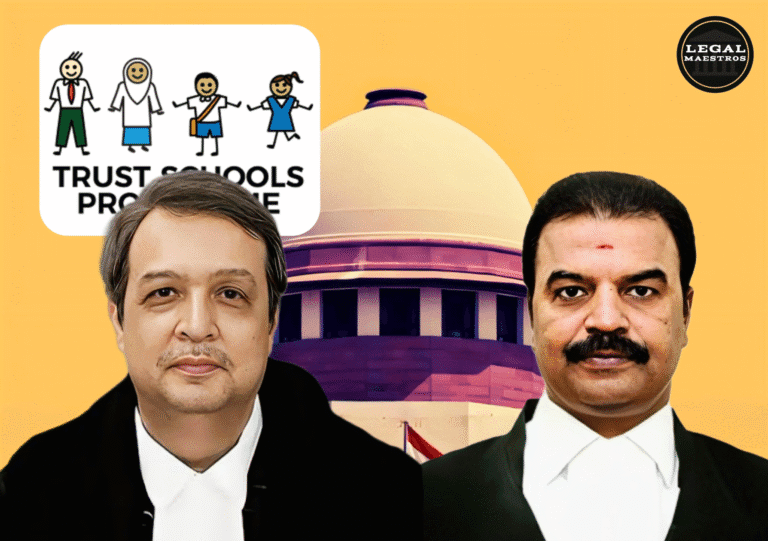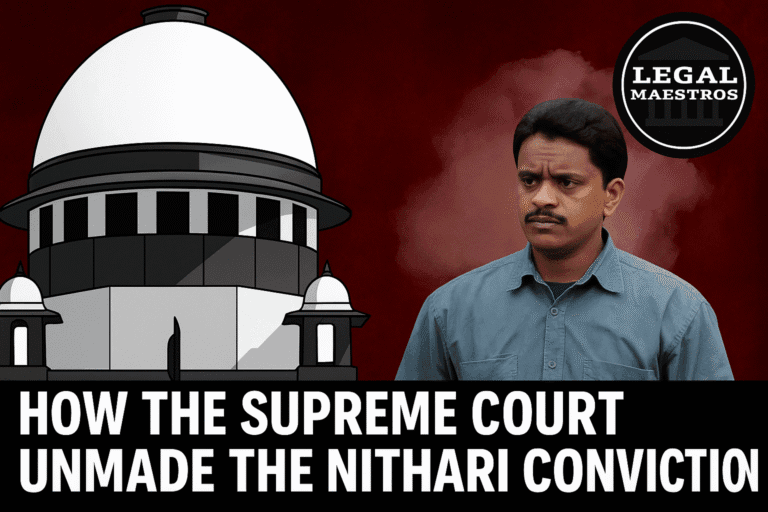
Supreme Court Upholds Threat-Based Extortion Charge Under Section 387 IPC, Justice Sanjay Karol Emphasizes Offence Completeness Without Delivery in Balaji Traders v. State of U.P.
Introduction
Providing clarity on the law of extortion as well as the extent of quashing powers under the Criminal Procedure Code, the decision that was given down by the Supreme Court on June 5, 2025, in the matter of M/s Balaji Traders v. State of Uttar Pradesh, was handed down on June 5, 2025.
Both the question of whether or not it is a violation of Section 387 of the Indian Penal Code (IPC) to threaten a person to pay money without actually delivering the money and the question of whether or not the High Court made a mistake in dismissing the criminal proceedings were deliberated upon by a bench consisting of two judges, Justices Sanjay Karol and Manoj Misra.
Facts of the Case
M/s Balaji Traders proprietor Prof. Manoj Kumar Agrawal made the claim that Sanjay Gupta and three accomplices threatened him with a firearm on May 22nd, 2022. The complaint was made by Prof. Manoj Kumar Agrawal.
For any queries or to publish an article or post or advertisement on our platform, do call at +91 6377460764 or email us at contact@legalmaestros.com.
They sought a monthly payment of ₹5 lakhs from him so that he may continue his business dealing with betel nut leaves. They attacked him and attempted to kidnap him after he informed them that he would not accept their offer.
Agrawal went to the magistrate in line with Section 200 of the Criminal Procedure Code when the local police refused to submit a First Information Report (FIR). “FIR” stands for “First Information Report.” In line with Section 387 of the Indian Penal Code, the magistrate established that there were prima facie grounds for extortion and issued summonses.
The plea that Gupta submitted to the Allahabad High Court was in accordance with Section 482 of the Criminal Procedure Code. Both the summons and the whole lawsuit were thrown out by the court, which lead to an appeal being filed with the Supreme Court.
For any queries or to publish an article or post or advertisement on our platform, do call at +91 6377460764 or email us at contact@legalmaestros.com.
For More Updates & Regular notes, Join Our WhatsApp group (https://chat.whatsapp.com/DkucckgAEJbCtXwXr2yIt0) and Telegram Group ( https://t.me/legalmaestroeducators )
Statutory Provisions
The Indian Penal Code defines the term “extortion” as a threat that results in the transfer of property or valued security. This definition may be found in Section 383 of Chapter XVII of the Constitution.
According to Section 387, which is concerned with the process of conducting extortion, the act of putting a person in fear of death or grave injury “in order to commit extortion” is the subject of the clause.
For any queries or to publish an article or post or advertisement on our platform, do call at +91 6377460764 or email us at contact@legalmaestros.com.
In accordance with this clause, only threats are subject to punishment. In order to prevent abuse of process or to guarantee that justice is carried out, High Courts are granted the jurisdiction to dismiss criminal cases by virtue of Section 482 of the Criminal Procedure Code.
Interpretation of Section 387 IPC
Section 387, which makes it a criminal violation to threaten to conduct extortion, was emphasized by the Court as being distinct from Section 383, which needs the actual transfer of commodities in order to be considered a criminal offense.
As a result of thinking on the wording of the Act as well as previous instances, the Bench arrived at the conclusion that the receipt of money is not a prerequisite for Section 387.
For any queries or to publish an article or post or advertisement on our platform, do call at +91 6377460764 or email us at contact@legalmaestros.com.
In order to extort money from a person, it is regarded to be a crime to place that person in a state of fear that they may die or suffer severe damage. Even in the event that the victim puts up resistance and there is no payment made, this is still the case.
Scope of Quashing Powers
As the Court shifted its attention to Section 482 of the Criminal Procedure Code, it emphasized that quashing is an extraordinary remedy notwithstanding the fact that it was previously under consideration.
The High Courts have the ability to interfere in this matter in the case that the proceedings show no cognizable violation, are obviously without merit, or represent an abuse of process.
For any queries or to publish an article or post or advertisement on our platform, do call at +91 6377460764 or email us at contact@legalmaestros.com.
The Supreme Court came to the judgment that the Allahabad High Court had applied these principles wrongly by re-evaluating the evidence and substituting its view on the merits. This was in contrast to the previous approach, which consisted of simply deciding if the complaint disclosed prima facie elements of Section 387.
Judicial Findings
The Supreme Court decided that the allegations fulfilled both of the requisite components of Section 387, which are the aim to extort ₹5 lakhs and the threat of serious injury at gunpoint.
This judgment was reached as a result of the Supreme Court’s analysis of the complaint and subsequent testimony from witnesses.
For any queries or to publish an article or post or advertisement on our platform, do call at +91 6377460764 or email us at contact@legalmaestros.com.
Due to the fact that the High Court did not take into account the differing legislative aim, the delivery duty that was initially incorporated in Section 383 was unintentionally imported into Section 387. This resulted in the order of quashing being overturned, and the procedures that were scheduled to take place before the trial court were brought back into consideration.
Conclusion
In this significant decision, the Supreme Court of India confirmed that the act of threatening damage in order to force payment encompasses the whole charge of extortion in its early stage, as outlined in Section 387 of the Indian Penal Code.
A warning was issued to higher courts to refrain from exceeding their jurisdiction by bringing attention to the limited scope of the quashing powers that are outlined in Section 482 of the Criminal Procedure Code.
For any queries or to publish an article or post or advertisement on our platform, do call at +91 6377460764 or email us at contact@legalmaestros.com.
It is guaranteed that victims can seek justice for threats even if there has not yet been a transfer of property, since the verdict maintains the strong interpretation of the Act and ensures that this is the case.




![JOB POST: Junior Associate at ASM Law Chambers, Jaipur [Freshers]](https://legalmaestros.com/wp-content/uploads/2025/11/Gemini_Generated_Image_8wrxer8wrxer8wrx-768x708.png)


